 |
||
|
||
| ||
Dear readers, you are asking us to test some definite models of motherboards, but excuse us: these months are so hot for new models, that we are highly limited in time for carrying experiments on what you are asking for. Nevertheless, in the nearest time possible you will see new authors which are going to give some more articles on regular motherboards, not super-new ones which will appear in the market only in several months. I think that the boards based on chipsets with DDR memory support will appear very soon. Meanwhile, we will introduce you two of them. DDR memory how it worksFirst, let's consider the memory that works at the same frequency as a usual PC100 and PC133 SDRAM modules, that is 100 and 133 MHz. For performance increase the new memory features a new architecture which has been used in video memory for a long time already write/read data from memory chips twice per clock Double Data Rate. DDR is controlled with the help of two inverse clock signals CK and /CK. All commands address and control signals are registered according to a positive front edge of CK signal when transferring from the low voltage to the high voltage level the same way as in a usual SDRAM memory. But the data can be received or output on the both fronts of the signal positive and negative. One more gating signal was added DQS for agreement of data stream which is given out by the memory while reading and by the memory controller while writing into the memory. This data are quite enough to understand timing charts of work of the most widespread types of memory.  In the memory chips they use a principle of pipelining while successive data are passing to the chip output, the chips can receive new addresses of lines and execute activation it allows minimizing the number of delays this is true for usual SDRAM as well. In addition to it, accesses to the memory are oriented only on the work with burst read/write operations and can contain 2, 4 and 8 successive I/O data blocks in the programmed sequence. The memory is accessed in two stages first, with ACTIVE command a line and necessary memory banks are chosen and activated for their access their addresses are already ready and are waiting for a command to proceed, and then with the commands READ or WRITE a sequence of memory accesses for read/write with usage of ready address of the first column is initiated. Let's consider this process in detail with the example of successive reading of blocks. Right before READ command with the help of Mode register the sequence length and order of blocks output (serial or interleaved) are set. Depending on the length of the set sequence and the order, 2, 4 or 8 successive columns are read - 2, 4 or 8 data blocks, and output of 1,3 or 7 blocks are executed at half a clock. But to be strictly exact, the reading of all N blocks are done at the same time, but because of the limited number of data outputs of memory chips each block is withheld on the output for a half a clock, and blocks are successively renewed on the outputs with the help of earlier mentioned DQS. This information is of course simplified but it's quite enough to understand how DDR memory operates. For deeper information refer to www.jedec.org. On the provided diagram you can see a successive reading of 4 blocks - the averaged case. It's obvious that in read/write sequences with two data blocks DDR memory goes along with a usual SDRAM, with four blocks you can see some difference, and with 8 blocks there is a significant advantage. On the diagram you can see what is CAS latency it is a delay in data appearing on memory chip outputs measured in clocks; and it is nothing but an interval between a registration of READ command and appearing of the first data block on the chips' outputs. Today there are DDR memory modules with CAS latency equal to 2 and 2.5. Later we will probably see some modules with CAS latency equal to 3 the slowest variant and 1.5 providing the best performance. As far as operating frequencies are concerned, there is the following gradation of DDR memory modules: DDR-200, DDR-266B and DDR-266A. These data show real frequencies of the memory 100 MHz in the first case and 133 in the two others. Here are the frequencies DDR memory chips are intended for.
It was decided to characterize DDR memory modules as PC1600 CAS2, PC2100 CAS2.5, PC2100 CAS2. The figures mean the memory bandwidth: 100 MHz (frequency) x 2(DDR) x 64(digit capacity) = 12800 Mbit/s = 1600 MBytes/s. Therefore, for 133 MHz memory this will be 2128 MBytes/s. Many ask how latency and frequency are connected to each other. There is so called a propagation delay a definite time intervals between the input signal and the resulting output signal. Clock frequency increase is the most obvious way to up the performance or bandwidth, but each device has its limit exceeding of which results in faults and failures because of the mentioned delays. In order to ensure memory work at higher frequencies they provide latency increase a necessary time interval to receive real data on memory chip outputs. With increase of a latency the memory can work at frequencies 10-25% higher the rated ones. And it's for you to decide what to choose higher frequency or less latency though everything is clear from diagrams, and as a rule, frequency increase is preferred more often.  Take look at sticker placed on DDR module. Modules marked as: A0(100MHz/200Mbps@CL=2), A2(133MHz/266Mbps@CL=2), B0(133MHz/266Mbps@CL=2.5). DDR memory modules can be stored at temperatures in the range from 50 to +100 degrees Celsius, and work at 0 to +55 degrees Celsius, with the voltage constituted 2,5 V against 3,3 V of usual SDRAM modules. DDR memory modules are shipping in two variants 200-pin compact SO-DIMM and 184-pin DIMM which is intended to replace SDRAM DIMM. The capacity of SO-DIMM modules can reach 512 MBytes, and of DIMM up to 1 GBytes. Memory modules are 64-pin, and for optional provision for ECC 8 more pins are used. In order to reduce costs of production process and provide a smooth transition from SDRAM to DDR the new modules were made to be the most uniform with their predecessors. The design of the memory chips is similar to a usual SDRAM: TSOP-II a cheap 66-pin plastic case suitable for 4, 8 and 16-digit chips. Today chips from 64 to 512 MBytes are available. When mass sales of DDR chips begin, the price will be only 2-10% higher, what is quite an acceptable solution. The printed circuit board for DDR modules are rather similar to usual DIMMs, first of all, in external sizes DDR PCB is completely equivalent to a usual one, but for one key (a cut-out in the bottom part) against two keys of a usual DIMM. Moreover, this key is located on the same place as in the usual modules. So, there is no any serious problems concerned with moving to DDR with the same price and other features similar to usual SDRAM the performance gain can go up as high as 10-15% - it's quite significant increase. Let's see whether it's true in reality. Of course, not everything works smooth. Overprice: until the market offers the deficit of DDR modules and plenty of SDRAMs their prices wouldn't get equal. In fact the price difference will keep 50 % and higher in the nearest several months, but remember that SDRAM modules are produced by third manufacturers, and DDR are exceptionally brand-names Samsung, Micron Then goes DDR memory that works at 100 MHz PC1600 will it ensure any performance gain as compared with PC133 SDRAM? It's unlikely. But if it does, it will be only sufficient to cover the price difference. Well, it looks like an intermediate variant to clean the road for PC2100, is it so? Then half a year later we will see PC1600 priced at PC133. And at last the BIOS. Raw BIOS's makes testers to fight against different faults, correct test results in order they correspond to theory, or to write the real facts, and a month later such reviews aren't actual anymore, since new BIOS's change much DDR chipsetsWhile Intel is alone with its Rambus trying to promote RDRAM, the companies that are dealing with DDR amalgamated in one team - TeamDDR (www.teamddr.com). This alliance combined efforts of memory manufacturers, developers of processors, chipsets, mainboards, standards etc. There are such companies as Micron, Infineon, Samsung, AMD, VIA, Ali, Nvidia, Jedec At first sight it seems that in chipset market segment everything is clear first it will be AMD with their chipset for the Athlon, then goes VIA But it's a completely different situation the first comes Acer Labs Inc. (Ali) that announced its MAGiK 1. The company had been under shadow for a long time the last chipset released in 1997 was Ali Aladdin 5 for Socket-7, it had a promising potential, though it lost in the competition with VIA chipsets, mainly because of the problems with the latest video adapters of that time, i.e. TNT2. After that ALI appeared only at Computex 2000 announcing not only the first DDR chipset ALI Magik 1, but also a board on it from Iwill company. Note that Iwill was a single manufacturer that released a board on the Ali; all others preferred to wait for chipsets from VIA who wasn't able to show anything but for posters and advertisements at Computex. Although the sample of the board wasn't workable, it was a significant jump forward. After a while when Ali started mass production of its Magik 1, VIA was still working on its chipsets. Soon, at Comdex there were already 11 boards on Ali Magik 1, and the company Iwill was the first to start series shipment of the boards on the latest DDR chipset. And it is exactly KA266-R board from Iwill that will participate in our tests. The second major feature of the new chipset, in addition to DDR memory, was possibility of FSB to work both at 100 MHz and 133 MHz, what makes 200 and 266 MHz as far as DDR bus EV-6 is concerned. And there we can see a well-balanced system the bandwidth of the buses chipset-processor (FSB) and chipset-memory become identical none would turn to be a bottleneck. But because of deep troubles when building up mainboards which support asynchronous operation with DDR memory this identity is not used by the manufacturers. That's why with a PC1600 memory you can make the processor work at 133 MHz. On the other hand, with PC2100 memory and in case of a changeable multiplier on a mainboard you can get the processor work at 133 MHz FSB just reducing the multiplier. And this method was applied to make our 800 MHz processor work at the 133 MHz bus ( the multiplier was set to 6 instead of 8). Note that the already existent Ali Magik 1, VIA KT133A, and upcoming AMD-760 and VIA KT266 will allow closer attention to the processors AMD Duron and Thunderbird. The procedure of overclocking of these processors with 133 MHz FSB won't only be simpler, but you won't have to manipulate with a multiplier, plus you can gain some performance at the expense of increase of the bus frequency. As for new Thunderbird processors from AMD with 133 MHz FSB, their frequencies start from 1 GHz and the whole series consists only of 3 processors. But let's return to the question. The chipset Ali Magik 1 consists of the M1647 Athlon Super Northbridge and the most advanced Sounth Bgidge which Ali has at their disposal M1535D+. 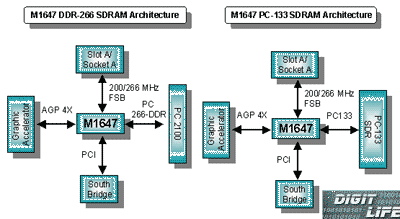 First up the North Bridge. According to the specs, the chipset supports up to 3 GBytes of DDR Memory. But considering that the manufacturers mount only 3 slots, and there is still no 1 GBytes DRR modules, it makes impossible to use the complete potential. But, is it so necessary? Ali positions their chipset as a cheap solution, plus there is a support (beside DDR memory) for 66/100/133 MHz SDRAM. Alterations in the design are very slight. And thus the chipset can become a strong competitor against VIA KT133A. Besides, if a manufacturer felt a desire, it can offer mainboards both with DDR and SDRAM slots. Of course, they may be used separately. And undoubtedly AGP 4x, without which it's just a shame to appear on the market. The South Bridge can be accessed via a usual PCI bus Ali considered either that 133 MBytes/s was enough or their desire to conquer the competitors overpowered and there was no time for developing a faster bus. The South Bridge meets the latest requirements, including a support for ATA 33/66/100. Let's look at the list of possibilities of the chipset, and compare them with our second participant VIA Apollo Pro266. 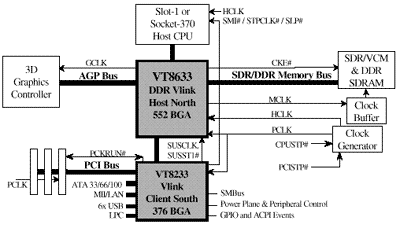
It's obvious that the Intel processors lag behind the AMD. Before, EV-6 didn't provide a great advantages to systems on Athlon, and without a possibility to increase the frequency significantly it was blamed by overclockers. But the time goes on, and after a while overclocking became possible with the help of a multiplier, then appeared a possibility to increase the frequency up to 133 MHz, and now, with the DDR, the bus became ideal that correspond s to the memory bus DDR SDRAM. But in any case you shouldn't say that DDR memory is useless in Slot-1/Socket-370 systems. In many operations, i.e. at AGP texturing the performance increase should proceed, and relatively considerable at that. In general, the possibilities of the new chipset from VIA are worth great praising in fact the mainboard on the Pro266 requires nothing but for a corresponding level of a video adapter i.e. Geforce2 Pro all other functions are provided by the chipset. Comparing with the Ali chipsets, DDR chipsets from VIA look much more attractive, mainly thanks to the features provided by the south bridges of the new generation, and to the high-speed bus V-Link. And a possibility to create dual-processor configurations on the base of the chipset Apollo Pro266 makes it very attractive for the market of high-efficient work stations the ratio price/performance of such systems will be perfect. BoardsAccording to the developers, the first cost of the mainboards based on the chipsets with DDR memory support should be about $6 more than for SDRAM. First of all it's connected with a necessity to use additional voltage pulse converters in order to provide the required 2.5 V, other clock oscillators and termination resistors. It will increase the price by 20 USD. 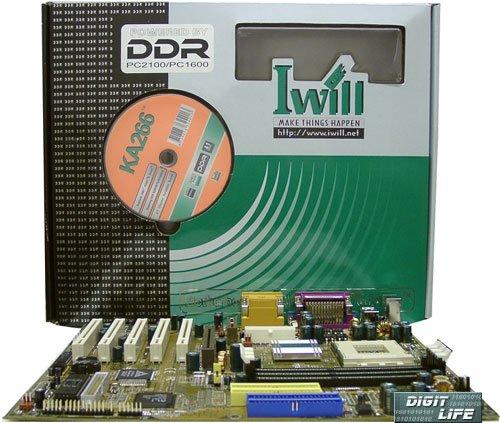  In order to attract consumers Iwill KA266-R will sell at 180-200 USD the engineers decided to equip it with all goodies. There you can find ATA-100 RAID controller from AMI - MG80649 the drivers of which continue improving, 4-channel hardware sound from C-Media CMI-8738, a perfect bright heat sink on the north bridge with the writing "Powered by DDR". All that, plus a magnificent box with interesting cutouts make this product belong Hi-End class. The design of the board proves that the developers spent much time to reach the small size of the PCB and the best layout of the components and the connectors. As far as stability is concerned, in general it's good but we should notice two things. First, stable work of the board was possible only with the set "CAS latency = 2" in BIOS; changing the value to 2.5 resulted in faults, when at 100, and 133 MHz at that. It seems that the setting parameters of CAS latency in BIOS are mixed up and it had been probably that while testing at 100 and 133 MHz memory frequencies CAS latency was equal to 2.5. This can explain such weak results showed by the system with the usage of PC1600 DDR memory. Secondly, the board buzzed when pressing the "Reset". So, we managed to restart it only after switching it off completely. We were a bit surprised with the unit of the multiplier adjustment which consisted of 4 jumpers. The operations concerning the setting of the multiplier to 6, which are described in the manual, are not true, and we had to set it after a definite number of attempts. And at last, when the processor required 1,85 V the board managed to give such only once per three-four times of the computer restarting. And on 8KTA2 in AUTO mode everything functioned without problems and the processor was given its 1,84 V. It's obvious that they should improve the BIOS, and probably make some alterations in the board. In spite of it the KA266-R is quite an attractive product. 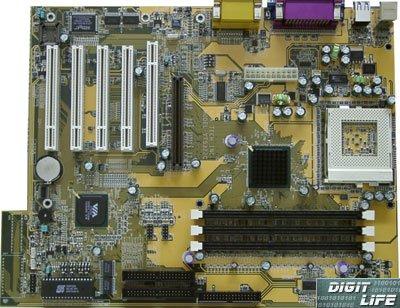 The second participant is VIA Tech Inc. It's an Engineering Sample (you can read it to the right of the AGP slot). It was difficult to install it in the case since there was a jut that prevented to do it. The board had nothing but a diskette with a new BIOS, and the positions of all DIP-switchers were shown on the board itself. Quite a stable work of the board allows supposing that in the nearest future we will see the boards on Apollo Pro266, and the BIOS will be extended by the manufacturers as they would like to do it. At this moment there are two possible ways of memory and processor operating 100 MHz FSB and 100 MHz DDR memory, and 133 MHz FSB and 133 MHz DDR memory. There is no option allowing you to set CAS latency yourself, and it probably is equal to 2.5. So, let's check the performance of the boards. Performance The following system helped us to estimate the performance:
Software:
 At the instance of our readers, we added the most famous professional OpenGL benchmark test from SPEC company SPECviewperf. It included the test sets of 6 OpenGL applications: Advanced Visualizer (AWadvs) from Alias/Wavefront, application for creation of 3D animations (11 tests), DesignReview (DRV) from Intergraph, a packet for viewing of 3D models (5 tests), Data Explorer (DX) from IBM an application for 2D visualization (10 tests), Lightscape Visualization System (Light) from Lightscape Technology an application for visualization based on radiosity algorithms (4 tests), Medium Mechanical Computer Aided Design (MedMCAD) several professional MCAD applications providing rendering in the real time mode (12 tests), and ProCDRS from Parametric Technology a packet of modelling and rendering for industrial use (12 tests). Then the results of each group of tests are average, and in the end we receive the results on each of six applications showed in FPS. All these programs belong to Hi-End class and realize rendering of the most complicated structures with the lighting, gradual shading, alpha-channel, lineal anti-aliasing and texture mapping. 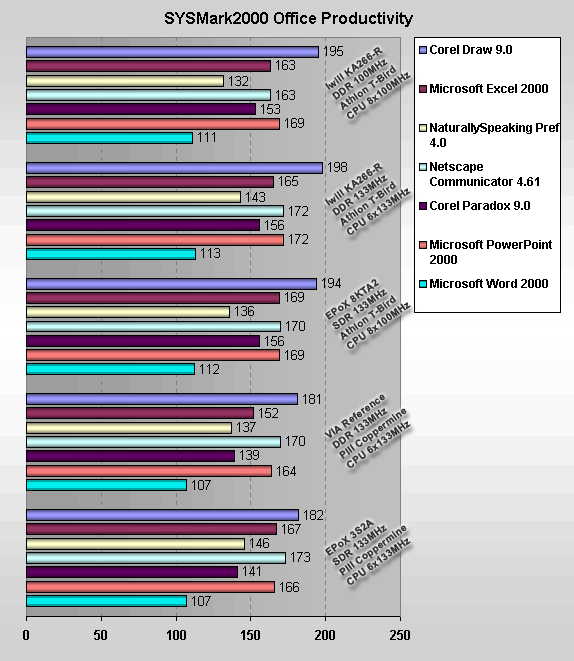 In the business applications the benefit of the DDR memory is quite low, and PC1600 DDR memory disappointed us even more. Nevertheless, when using 133 MHz FSB and PC2100 memory Ali Magik 1 wins. We only hope that new versions of BIOS and drivers from Ali and VIA will get the things better in the future. 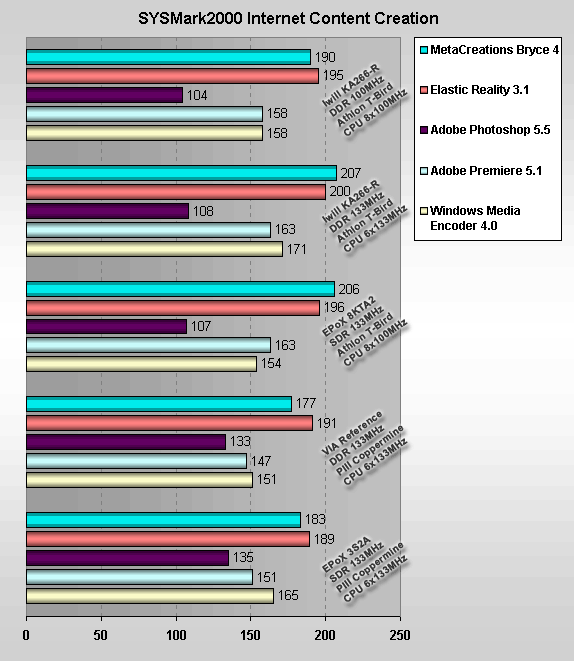 Almost all the results are at the same level. DDR memory helped only in the Elastic Reality, and 133 MHz FSB allowed the Athlon to perform well in Windows Media Encoder 4.0 do you remember how brilliant was Pentium 4 there with 400 MHz FSB (100 MHz Quad Pumped Bus)?  A hard load on the memory bus and FSB allows reaching rather high results especially at high resolutions even now, and with a proper optimization it will be obvious soon that DDR platforms feature very promising future. But it doesn't concern much PC1600 DDR memory.  Undoubtedly, Athlon 133 MHz FSB and PC2100 DDR makes the most promising combo for the professional graphics. Of course, Pentium 4 demonstrates yet higher results, but look at its frequency and the price. ConclusionWell, it's not a revolution, but DDR systems' results are quite impressive. It will take a little time when optimized BIOS's from mainboard manufacturers and new drivers from chipset manufacturers will be able to outperform its SDRAM-based competitors. As for DDR memory, it's obvious that PC1600 memory can't provide an acceptable level of performance and it's very likely to become an intermediate stage. The PC2100 will be replaced by the standard DDR-II which is being developed now; it will ensure a bandwidth from 3.2 GBytes/s. And considering that the first price of DDR memory is practically equal to that of a usual SDRAM, none would doubt what will become a standard a year later. The perspectives of the new chipset from Ali, Magik 1, are not optimal - in the nearest time it will have to conquer upcoming competitors AMD760 and VIA KT266 that probably could provide a greater benefit of the DDR memory. But in case of misfortune the company can decrease the price and put the chipset into the production of mainboards under a usual SDRAM memory, and in this segment there is only the VIA KT133A as a competitor. The Ali has DDR chipset for the Intel processors Ali Aladdin Pro 5 but it faces quite a strong counterpart VIA Apollo Pro266, that features greater possibilities. It would be pity if it were not BIOS and drivers to blame, but the memory controller in the chipsets from Ali would turn to be slow In this case Ali will be in poor situation. OK, let's wait a bit and see what there will be in the end products.
Write a comment below. No registration needed!
|
Platform · Video · Multimedia · Mobile · Other || About us & Privacy policy · Twitter · Facebook Copyright © Byrds Research & Publishing, Ltd., 1997–2011. All rights reserved. | |||||||||||||||||||||||||||||||||||||||||||||||||||||||||||||||||||||||||||||||||||||